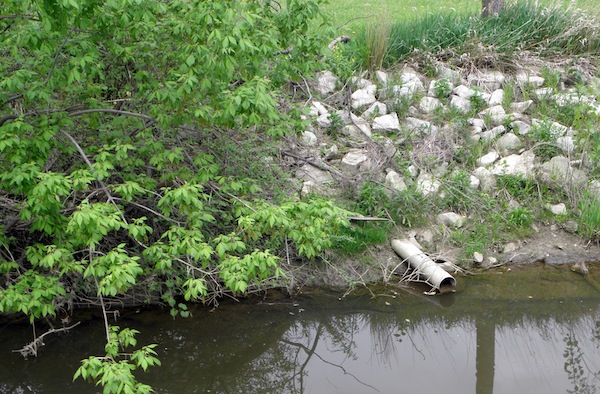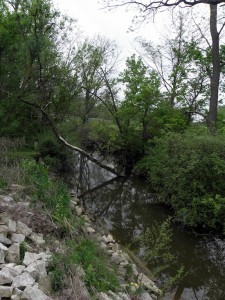
Many small streams are already compromised by drainage of fertilizers from farm fields. Photo: Karen Schaefer
Listen to the story here…
To see latest number of fracking wells in Ohio, click here.

Karen Schaefer is an Ohio freelance journalist and independent radio producer.
By Karen Schaefer
ANCHOR INTRO: This year, several Great Lakes states have seen a sharp spike in the number of new wells drilled by companies fracking for natural gas. In Ohio new wells are up 80-percent since 2012. And it’s a thirsty business. Each well requires millions of gallons of water. As independent producer Karen Schaefer reports, environmentalists are concerned because, at least in Ohio, there are virtually no limits on how much water gas-drillers may use.
AMBI: Car passing by, under:
SCHAEFER: At a rural crossroads in Lorain County in northern Ohio, Sam Rubin is standing at a guardrail on a bridge overlooking the tree-shaded waters of a small stream. There’s not much water in this tiny tributary of the nearby Vermilion River. But Rubin says there was even less last year when he watched a water tanker drive up and flop its hoses over the guardrail.
AMBI: Rubin bangs on guardrail, under:
RUBIN: This guardrail, at one point last summer, had two massive three-inch hoses wrapped around it that snaked over this embankment here and sat in that stream.
SCHAEFER: Rubin is a student at nearby Oberlin College and an anti-fracking activist. He says at the height of last summer’s drought, he watched as the water tanker nearly sucked this stream dry.

Environmental groups worry that removing too much water from small streams will kill aquatic life. Photo: Karen Schaefer
RUBIN: A 5-thousand gallon truck would drive here and he’d park, maybe on the bridge itself. And he would hook up these two tubes to the tanker. And he would fill up his truck and drive the two miles to the drill site and give them the water there. And then he’d repeat. And he did that for five days in a row, just all day filling up and dropping off water.
SCHAEFER: Rubin says despite the thousands of gallons of water taken from this stream, he’s pretty sure the driver was operating legally. Ohio’s reasonable-use water law allows drillers to take up to 100-thousand gallons of water a day before registering their water usage and its source with the state. And that worries Melanie Houston, director of water policy and environmental health at the Ohio Environmental Council.
HOUSTON: When you’re essentially removing all the oxygen out of a stream, the aquatic life is going to be deprived of their form of oxygen, what they need to survive. So if you’re doing that, even for short periods of time, the aquatic life is likely, depending on how much you dry up the stream, going to perish in that period of time.
SCHAEFER: Houston says, depending on the time of year, spawning habitat for fish, amphibians, and insects could also be affected. And while most Ohio water quality impacts are overseen by the Ohio Environmental Protection Agency, this one is not. In Ohio, oil and natural gas drilling — along with water withdrawals for drilling and any of its impacts — are regulated by different divisions of the same agency, the Ohio Department of Natural Resources.
KARL GEBHARDT: At this point in time, we’ve seen no direct negative impact to a water resource as a result of fracking or any other water use.
SCHAEFER: Karl Gebhardt is chief of the Division of Soil & Water Resources at ODNR. He says so far, the amount of water used for fracking has been negligible compared to other industry uses, less than one-percent of the total. But he says as the gas drilling industry in Ohio evolves, his agency is being mindful of the possible impacts to high-quality streams and wetlands, like that of habitat for hellbenders, the largest of North American salamanders.

Anti-fracking activist Sam Rubin watched this stream sucked almost dry by drillers last year. Photo: Karen Schaefer
GEBHARDT: There was a potential for water withdrawal upstream from hellbender habitat. And we were notified about it, went in and worked with the company that was wanting to make the water withdrawal to advise him of the situation. And he found a different place to go.
SCHAEFER: But ODNR has no regulatory tools, apart from private discussions with gas drillers, to enforce any restrictions on water withdrawals. And private landowners who find their ponds or streams emptied by water withdrawals from drillers have no recourse except to appeal to ODNR — or the courts. And there’s one other issue that concerns the Ohio Environmental Council’s Melanie Houston.
HOUSTON: This is a consumptive use of water. And so the sheer volume of water — you know, the 5-7 million gallons of water per frack, and there can be multiple fracks at each well pad — that’s water that’s not going to be re-entering.
SCHAEFER: In other words, unlike most other water users in Ohio, drillers are not required to return the water they use — usually contaminated by fracking chemicals – to the source. One exception is the Lake Erie basin, where water consumption is governed by a recent bi-national treaty called the Great Lakes Compact. The Ohio Environmental Council would like to see changes in state law to allow for greater clarity of oversight of water withdrawals for fracking. For now, both the state Department of Natural Resources and environmental groups are awaiting the results of a US Geological Survey study of the impacts of fracking water withdrawals in the Muskingam watershed. For Ohio Public Radio/For Great Lakes Echo, I’m Karen Schaefer.
Related story: A Michigan angle
Karen Schaefer’s series on Northeast Ohio/Great Lakes water quality – Drink, Fish, Swim — is supported by a grant from the Burning River Foundation.
Petition to stop fracking in the Great Lakes Basin to be delivered to Governor Rick Snyder of Michigan and to the Great Lakes Basin Compact:
https://secure.avaaz.org/en/petition/Stop_Fracking_in_the_Great_Lakes_Area
Pingback: Environmental Health News on Fracking August 15, 2013 | Boulder County Citizens for Community Rights